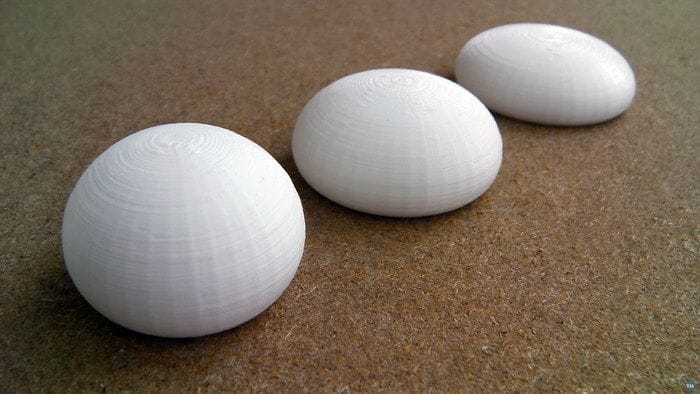 3D printed Liquid Drops
3D printed Liquid Drops
This week’s selection is the fascinating Liquid Drops by YouMagine contributor Tiago Charters de Azevedo.
It is a collection of, literally, droplet shapes that look eerily accurate.
While their shapes are straightforward and familiar, it is the manner of their creation that is of most interest. No, they were not 3D scanned at high speed.
Instead, they were mathematically generated based on physics. TCA explains:
Drops of liquid are described by Laplace’s equation. There’s only one non-dimensional parameter beta that controls the shape of any drop, beta = g rho b^2/T where g= gravity acceleration, rho=density, b=curvature and T=superficial tension.
The profile for each drop was obtained by numerically solving Laplace’s differential equation[1] for the corresponding beta value and a simple GNU/Octave script for generating the final STL. beta>0 corresponds to standing drops, for beta<0 we have hanging drops and beta=0 gives a sphere. All the drops have a volume of 33510 mm^2, the same volume as the typical ping-pong ball 😉 As a consequence all drops weight almost the same with 100% infill.
 More 3D printed liquid drops
More 3D printed liquid drops
I’ve seen many examples of incredible 3D prints that have been created by mathematical generation, but virtually all of them have had “unbounded” approaches that result in fantastic shapes. This set of 3D models is quite different in that it is simulating reality and transforming that simulation into a physical reality.
It’s a physical manifestation of a simulation of a real physical phenomenon. That’s a very cool thing to write!
The set of Liquid Drops includes several droplet shapes in various stages of existence. By looking at them you can almost “see” the motion of the drop forming above, extending and then falling to a surface where it spreads and settles.
 3D printed Liquid Drops in a sequence
3D printed Liquid Drops in a sequence
If printed and displayed, I’m sure visitors will think “hm, some droplets, yes.” But you can smile, secretly knowing the true geometric provenance of the otherwise normal-looking droplets.
I’m not quite sure of the practical applications of this very subtle design, but it does suggest the possibility of simulating other real-life phenomenon and producing 3D models and prints from them.
What phenomenon would you like to print?
Via Printables

